1788-1789: Crell’s Annals of Chemistry Part 1/2: The state of chemistry in Hahnemann’s days.
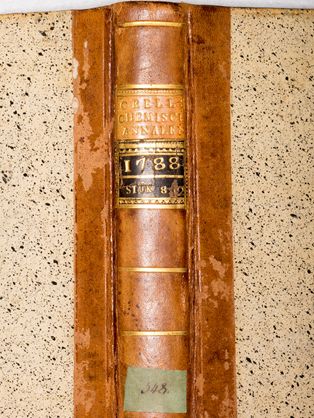
Abstract: Dr. Samuel Hahnemann was a chemist, pharmacologist, physician and homeopath. With this and other essays, the International Hahnemann Center Torgau tries to display the efforts he took to contribute to the development of all these sciences. Many of his findings are accurate to the present day. Our historic books are witnesses of that time period and we should present them to you for a better appraisal of Hahnemann’s accomplishments. We hope that you will get an idea how difficult his research in these fields really was.
Dear readers of Homeopathy for Everyone, our next two newsletters from Meissen will be essays on chemistry of the late 18th century. We will read about Dr. Samuel Hahnemann as an early chemist, but even more about chemistry during those years.
We will learn that Hahnemann published essays in journals together with the most famous chemists of the time and that these scientists did an incredible job in their efforts to throw light on chemical processes never understood before.
In two parts of our messages from Meissen we will first have a look at how chemistry was understood in the late 18th century, and then we will dive briefly into Hahnemann’s pre-homeopathic research in this field.

With our newsletters you will see: Hahnemann was a dedicated scientist in many fields. The International Hahnemann Center Torgau obtained three issues of Crell’s Annals published in 1788 – 1789 with essays written by Dr. Samuel Hahnemann.
At that time elements and chemical bonds were still in the process of getting discovered. Chemists began to ask, what are the elements of any substance?
They were searching for the “fundamental essence” of bodies. They were inquiring, “What unknown something lies hidden in them?” An example will show the great confusion which still prevailed in chemistry.
Lorenz Crell, publisher of the Chemical Annals was Professor of Medicine and Philosophy in the Brunswick University at Helmstadt, Germany. His Annals were very important for the history of chemistry. They appeared monthly from 1784 on and they were the first regularly appearing chemical periodical in Germany.
Soon they were imitated in the French Annales de Chimie. Crell met the expenses of his undertaking by subscription; the list of subscribers contained many names of princes, academics and students in all countries; apothecaries were especially numerous.
The foremost chemists and natural philosophers, such as Gmelin and Alexander von Humboldt were contributors. French chemists also contributed papers. Hahnemann published a series of interesting and approved experiments and discoveries in these Annals.
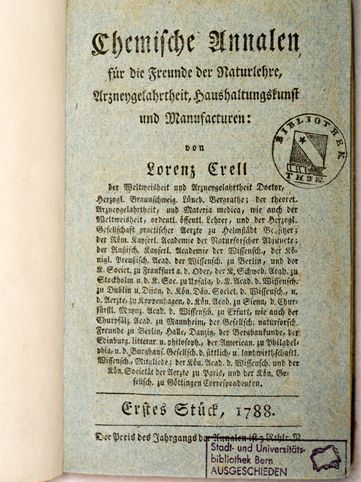
Now, just imagine: you are a traveller and your flight arrives in a country where you have never been before. You’ve got no information about it. It is up to you to find out about the places and the people; their culture and their customs.
You can’t speak their language. It is you who has to collect all the data so that your family at home will get a clear picture of this ‘new’ area.
You have got your passport with you, a wallet and your luggage. And here you are: in front of an airport terminal and from here you are expected to explore this country.
Where will you go? What are you going to expect. say for the next three weeks before returning back home? How will you begin your enterprise? What will be your first steps?
And here we are in 1788 when we arrived at a new science called chemistry. We have no idea about real chemical processes. We only have a few methods and instruments helping us to investigate processes by which substances change their appearance.
What is going on when substances change their colour, smell, temperature, aggregation state? You know what? Let us do this journey together, just for the time it takes to read this essay. May I please propose a topic?
“What happens in combustion?”
Let us just have a look at a piece of wood. What does it consist of? Let’s do a simple experiment: Just take it and throw it into a fire. The wood will burn and what remains are its ashes.
The other parts of it have just evaporated: this vanished part we call the phlogiston. As a result, we just have found out that wood consists of ash and phlogiston. But how could these components be separated? Can they fuse again?

In 1788 scientists quarrelled among themselves a lot about the theory of the phlogiston.
Professor Johan Gadolin, a chemist from Abo, Finland, writes an essay in Crell’s Chemical Annals, 1st booklet of 1788:
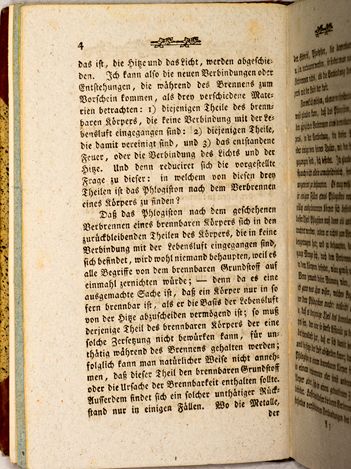
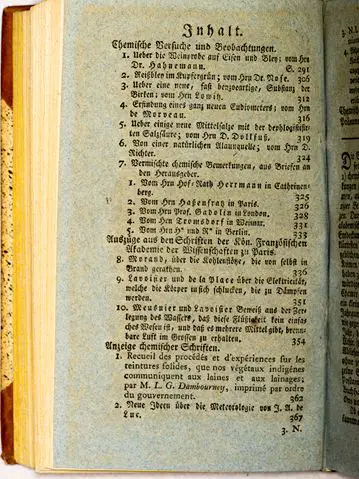
Gadolin proposes that we suppose that the phlogiston exists. It is a combustible basic substance which is found in all burnable things. It is the basic cause of combustibility.
What will happen to it while something is burning? First, it is prerequisite that there is breathable air. Next, the basis of this air unites with some parts of the combustible material. Then fire, which is heat and light, will be separated from our source material.
This means that we have three new compounds: 1. the parts of the combustible corpus which has no bonding with the air, 2. those parts bonded to air, 3. the fire, which is heat and light. The question now is: in which of the three parts will we find the phlogiston after combustion?
There is no doubt about it, that it will not be found in number 1. because it doesn’t burn. In case that some of the phlogiston remains in number 2, then we can consider this part as inactive. What remains is, that during the process of combustion, the phlogiston separates from the burning substance becoming part of the fire.
But fire consists only of two parts: heat and light. Both need to be considered as substances. The phlogiston has to be situated in one of the two. The trial done by Mr. D. Crawford proved that all the heat produced got separated from the air. This substance seems to be of such an elementary nature, so that we have not yet found a bonding to other bodies.
From this we conclude that the phlogiston is merged with light. But Mr. Scheele gives reason that light is the conjunction of the phlogiston with heat. I think, if heat is oversaturated with phlogiston, the light is expressed…
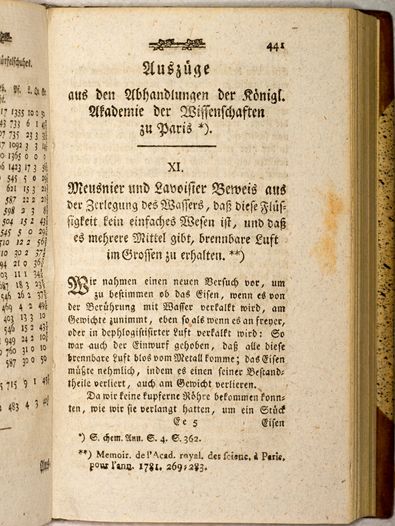
On 14 pages in the book we read about this philosophy, about the nature of the phlogiston.
Next, in the very same journal, we are going to focus on an essay by Antoine Laurent de Lavoisier. Together with Jean-Baptiste Meusnier de la Place he has found out that electrolysis can produce a gas (without knowing that it was an element, Hydrogen).
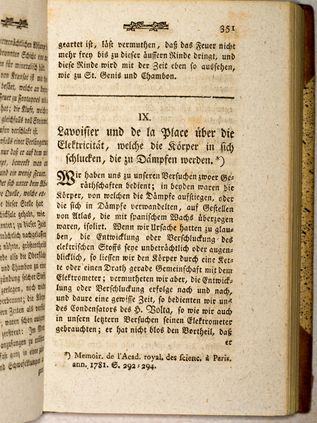
In a short essay, Lavoisier tells us about his observation when pouring vitriolic acid diluted in water on parts made of iron. He used a capacitor invented in 1775 by Mr. Alessandro Volta (he called it “electrophorus”).
A vivid effervescing occurred and much inflammable air was produced. After some minutes Volta’s capacitator got charged as much as to produce a pretty strong spark.
A short time before Lavoisier, the chemist Joseph Priestley had discovered another gas which he called ‘dephlogistigated air’. As it was found out that this air alone maintained the life of animals, it was called ‘vital air’. In this air, combustive solids burned much faster and stronger than without.
In the next essay by Lavoisier, we find a report about trials telling about findings, that nature has deposited in water all inflammable air which is used to produce chemical compounds. This is the first elaborate explanation of the idea of oxidation in Crell’s Annals – when the term ‘oxidation’ was still unknown.
In another essay Lavoisier states that he began his trials with water in 1776 and 1777. It is really fascinating to read about it and how conclusions were drawn. Early Chemists were investigators no less than Sherlock Holmes. Those scientists invented many different setups for chemical experiments.
Lavoisier could tell in 1788 that the components of water had the ratio of 12 parts of “vital air” and 22.924345 parts of combustive air. Lavoisier was aware that this number may not be accurate. (Lavoisier and his wife in 1788: https://www.metmuseum.org/art/collection/search/436106) There was still some uncertainty about the exact ratio. Remember, he knew nothing about a chemical formula like H2O. Lavoisier expected that one pound of water was 0.86866273 pound of “vital air” and 0.13133727 pound of combustive air (today we know that it is 0.8883 pound of oxygen and 0.1121 pound of hydrogen). Amazing, isn’t it?

On the other hand, even Lavoisier was prone to draw wrong conclusions: Later in this book he stated that water plays a dominant role in the growth of plants, and the vessels in the leaves excrete a large amount of “vital air”.
Therefore, water is broken down into its components within the plants. But it must have broken down in another way than it was found out before.
The “vital air” is released and the combustive part of water remains to form the plants carbon, its oils, everything combustible. “All these entities seem to be still unknown modifications of the combustible element of water” he wrote.
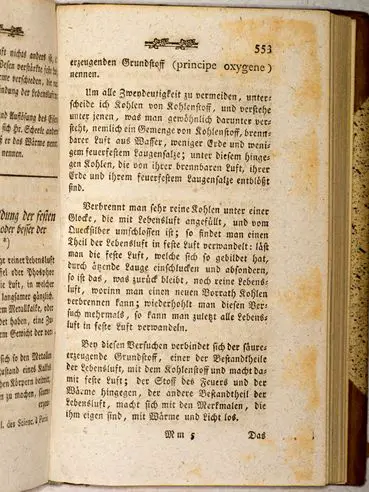
It is clear that Lavoisier could not be aware of photosynthesis.
On page 550 Lavoisier writes that in all experiments with metals, sulphur and phosphorus air combines with these solids. It gets locked in them. By the fusion with the new element they become either what they called calxes or acids.
Lavoisier found out that on burning phosphorus it gains more than half of its weight. It comes from the air combining with it to become phosphoric acid. After combustion, calcination or similar processes, air always will be found in the residue.
When burning phosphorus with pure “vital air”, the air vanishes and the product gains weight exactly corresponding to the amount of the air absorbed (Today we write P4 + 5 O2 ─> 2 P2O5).
Lavoisier states: “I like to name the entity which combines with metals to set them to calxes and which adds to combustible solids to make them acids ‘acid-generating element’ (principe oxygene) [pg 553].
While early chemists Carl Wilhelm Scheele and Joseph Priestley independently discovered oxygen (without knowing details about it), it was Lavoisier wo proposed the term oxygen.
In his works Lavoisier could prove in 1785 that the theory of the phlogiston was wrong. Two reasons inevitably supported his views: In calcination (that is oxidation) of metals, the metals gain weight.
With the loss of phlogiston, they should have lost weight. Next, Lavoisier could prove that water consists of Hydrogen and oxygen. This could explain for example why iron rusts in water without the presence of air.
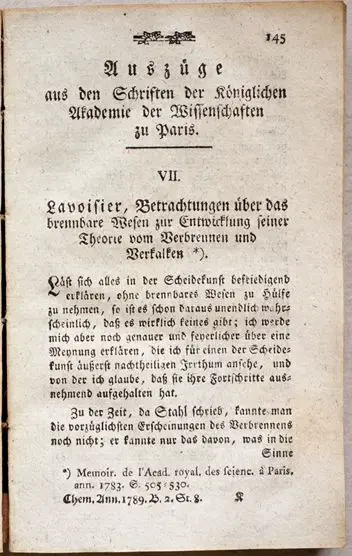
In Crell’s Annals of 1789, which also is in the collection of the International Hahnemann Center Torgau, Lavoisier elaborates again on 32 pages about his findings and he defends his conclusions against those still insisting in the phlogiston theory. It is thrilling to read the dispute.
We can witness living science in these old books! And this is where we arrive at our destination of this short excursion into the history of chemistry. Please keep in mind what you have learned today when reading about Dr. Samuel Hahnemann as a chemist next time. You will then understand, what a brilliant mind he was. Who else beside him could have developed homeopathy? I don’t know…
If you’d like to see these books, then come to Meissen when you travel in Germany and visit the International Hahnemann Center Torgau when it has opened its Hahnemann exhibition. Or even better, think of becoming a member and of being part of our adventure tracing homeopathic history:
Perennial Membership Privilege:
- Certificate
- Visa assistance at your embassy upon invitation.
- Free admission to the exhibition in Meissen
- News from Meissen and the exhibition, free newsletter
- 10% discount for travel or tour companions on the trail of homeopathy
- Free coffee and tea in Meissen
- 10% discount on IHZT courses, congresses or training courses
If you are from India, our Indian Ambassadors will guide you in acquiring this membership. A 12 year membership fee is 200 euros,
You can contact any of our ambassadors via WhatsApp:
Dr Rajesh Kumar +919349496252
or
[email protected]
or
Dr Sudin Kumar +919496285515
( See part 4 in the August 2022 issue of Homeopathy for Everyone)






